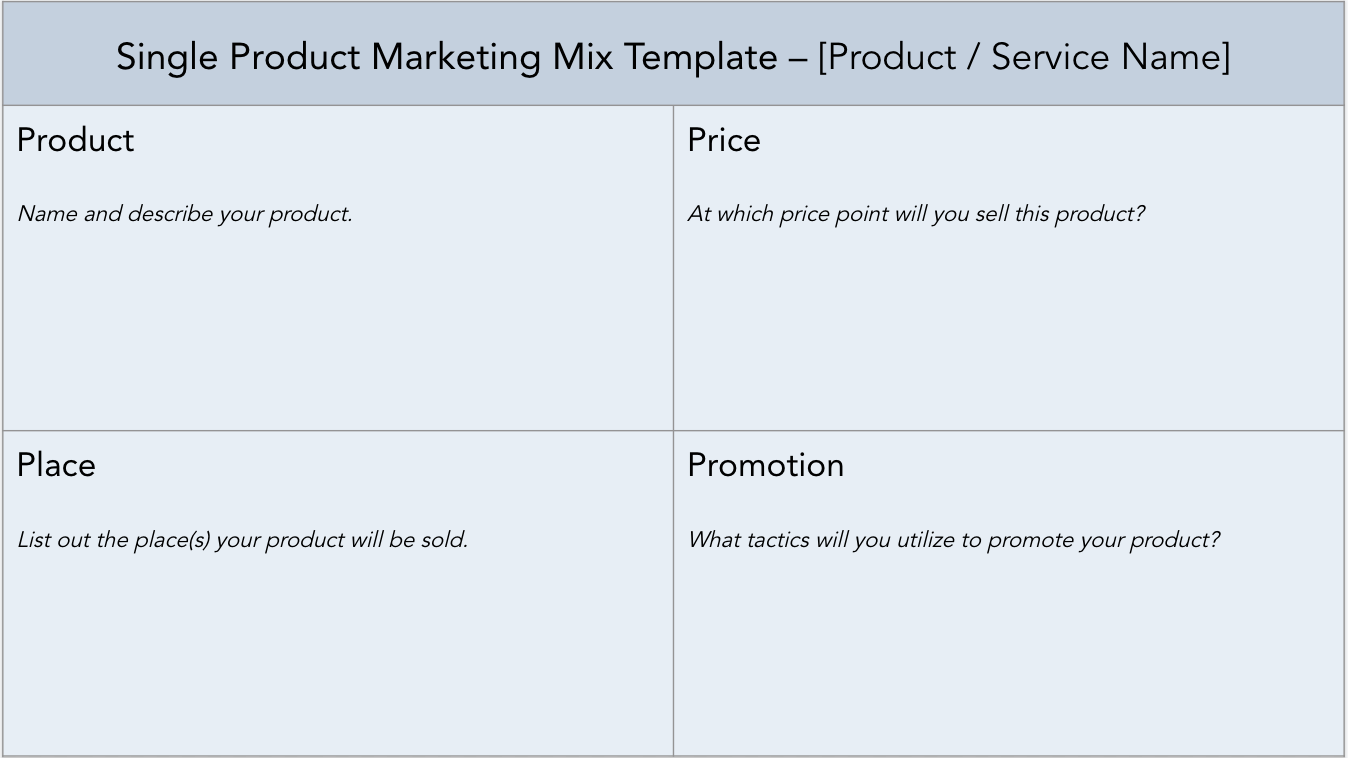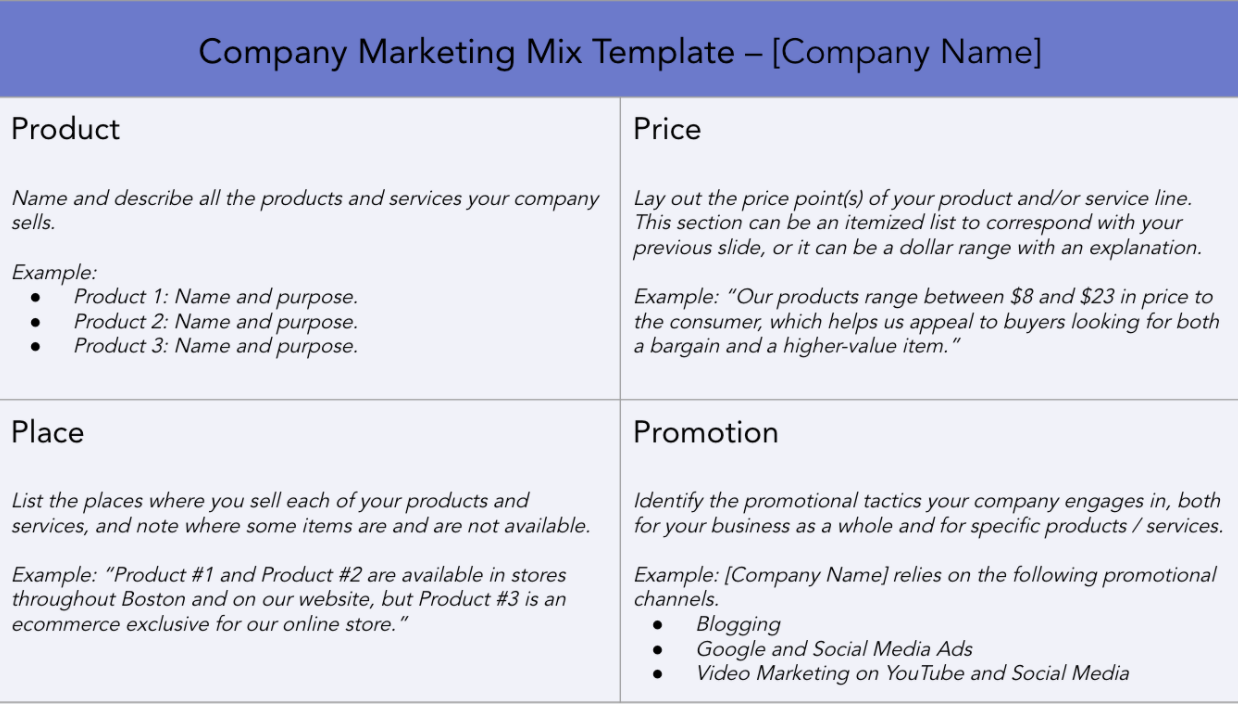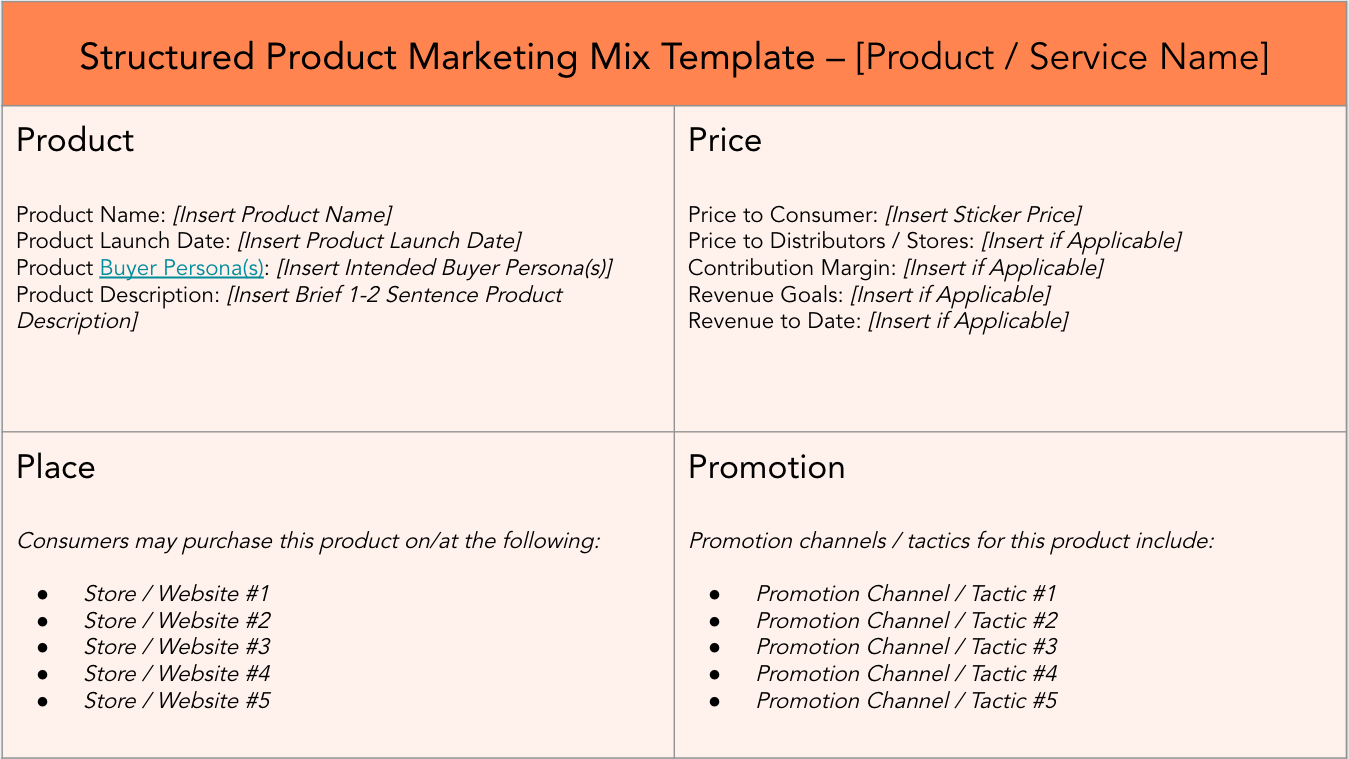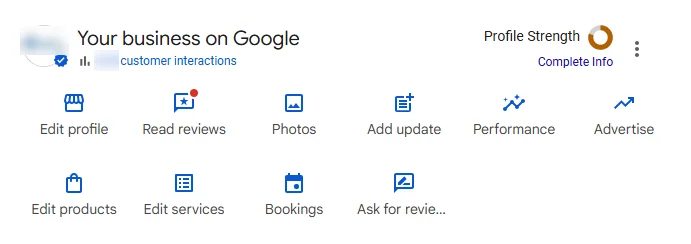One of the first things you're taught in your Introduction to Marketing class is that marketing can be best explained using the marketing mix — also known as the four P's.
They are — and say 'em with me, because if you took that class, you know these four words by heart:
- Product
- Price
- Place
- Promotion
Effective marketing touches on a broad range of areas as opposed to fixating on one message. Doing so helps reach a wider audience, and by keeping the four Ps in mind, marketing professionals are better able to maintain focus on the things that really matter. Focusing on a marketing mix helps organizations make strategic decisions when launching new products or revising existing products.
One of the first things you're taught in your first marketing internship or job, however, is that marketing entails so much more than can be simplified in a four-section marketing mix matrix.
Still, there's an undeniable benefit of marketing teams organizing their work into the marketing mix framework.
When you stray too far away from the four P's, it can be easy to lose focus on your purpose as a marketer.
Marketing truly is about teams and individuals working together to promote a product in the right place at the right price point. Efforts beyond this scope are essential, but they do all stem off of this foundation of the marketing mix.
Here, we're going to dive into what a marketing mix is and how to develop a successful marketing mix strategy for your own company.
What is a Marketing Mix?
The marketing mix refers to the actions a company takes to market its product(s) and/or service(s). Typically, it acts as a framework for breaking down the four key components of marketing — product, price, place, and promotion.
The marketing mix helps companies organize their marketing initiatives by task and department for more process-driven and impactful marketing campaigns.
This framework has roots back to the 1940's and has been evolving ever since. While some elements have been added or tweaked over the years — most notably for the modern digital age — the core elements of the marketing mix (i.e. the four P's) have remained consistent for decades.
Featured Resource: Marketing Mix Templates

Need a way to visualize your marketing mix to share it with your employees or investors? Use these four marketing mix templates to organize your initiatives and activities by the right section. Click here to download them now.
Marketing Mix Elements
The core elements of a marketing mix are product, price, place, and promotion — known as the four P's of the marketing mix. When perfected and synchronized, these elements provide a well-rounded approach to marketing strategy.
1. Product
Product refers to what your business is selling — product(s), service(s), or both. The bulk of the work in this element is typically done by product marketers or managers. Nailing the product element of the marketing mix means doing extensive research and development, understanding the need for the product, developing a product launch plan and timeline, and educating customers and employees — especially salespeople — on the product's purpose.
2. Price
Price refers to the price point at which you'll sell your product(s)/service(s) to consumers. Arriving on this dollar amount requires consideration of multiple pricing strategies, analysis of similarly priced products in your market, and insights from consumers through surveys and focus groups. Price speaks to positioning in the market, the speed at which you want to penetrate your market, and your company's revenue goals and profit margin.
3. Place
In the marketing mix, place refers to where your product or service will be sold. For tangible products, this will include physical locations such as your own store, or a retailer where your product will be resold. It can also include the other methods where your products can be purchased, like online or over the phone.
4. Promotion
Promotional activities are those that make your target market aware and excited about what you're selling. While this does include paid initiatives like commercials and advertising, promotion also entails organic initiatives like word-of-mouth marketing, content marketing, and public relations.
Other Elements
While the marketing mix can often be simplified down to the 4 P's, the expansion of the scope of marketing in recent years has resulted in more P's added to the list.
For example, Smart Insights includes the following elements in its marketing mix definition:
- Process, or the large internal initiatives taken to support a product launch, such as including salespeople in goal setting.
- People, which can refer to your buyer, market, and target audience, or your internal team responsible for launch.
- Partners, or who you'll be working with outside of your company, such as distributors or co-marketing partners.
Some of the other P's can include:
- Payment, or how transactions will be held and processed.
- Physical evidence, or anything tangible pertaining to your product or service, like any materials needed to complete your service or deliver your product.
- Packaging, or anything pertaining to the physicality of your product, like how it looks or how it's packaged.
These other marketing mix elements should be utilized as you see fit for your projects. However, every good marketing mix should rely on a thorough exploration of those first 4 P's of product, price, place, and promotion.
How to Develop a Marketing Mix Strategy
Because the marketing mix incorporates elements from across your department — and even your company — it's imperative to establish a marketing mix strategy for each product you launch, or for your company as a whole. For a fully-fleshed out marketing mix, follow these steps.
1. Engage in market research and product development.
The success of your marketing work is first and foremost contingent on your product. Make sure it's well-developed and your team can speak to its benefits and the story behind it.
Best practices in this step include:
- Engaging in market research to understand your buyers' needs.
- Speaking to your current customers to see what needs to be added or changed about your current product or service line by uncovering their pain points and insights.
- Monitoring industry trends to identify a potential demand in your market.
- Examining the competition.
- Collaborating with your product team during product development to ensure it meets your buyer personas' needs.
- Have your product tested by current customers to see how they're using the product and if it's actually solving for their problems.
Taking these actions ensures you're making every effort to understand and solve for your customer, providing a solid foundation for your product to launch successfully.
Featured Tool: Market Research Kit. To make your R&D more impactful, use these free market research templates so you can better understand your customers and competitors.
2. Determine your pricing model.
A lot goes into choosing a price point — so much so that we wrote an entire guide to pricing strategies.
Luckily, you'll be able to refer to much of the work done in the previous section. Thanks to your understanding of your market through research, you'll have answered most of the necessary questions in this section. You'll also need to take your costs into account so you can maximize unit sales and profit.
During this stage, make sure you do the following.
- Speak to customers (or refer to previously completed market research) to determine the ideal selling price.
- Work with the product team to ensure the product can be developed in a cost-effective manner that would ensure profitability at your target price point.
- Meet with finance to determine aggressive yet realistic sales forecasts to contribute to the company's bottom line.
- Collaborate with sales to determine to what extent discounting should be allowed or utilized.
- Determine how you'll adjust price and revenue forecasts when selling through resellers.
- Lastly, don't forget to factor in the perceived value by the customer. Even if your product or service doesn't cost a significant amount to make, you'll be able to mark up your product more if you face little competition and provide an irreplaceable benefit to your customers.
Featured Tool: Pricing Strategy Calculator. If you need help selecting your pricing model, use this template to compare different pricing strategies and see which will yield your company the most profit and revenue based on your forecasts.
3. Choose your distribution channels.
The place part of the marketing mix answers where your product will be sold. Keep in mind, this can be any combination of your store, a distributor's store, or online. You'll want to address the following points before moving onto the promotion stage:
- Determine if your product will fare best in your physical location, a store of another retailer, on your website, on another company's website, or some combination of these locations.
- Think about geographic location — make sure your supply meets regional demand, and plan for whether or not what you're selling will be available in a certain city, a state, the country, or worldwide.
- Come to an agreement with retailers and resellers on margins, markups, and MSRPs.
- Figure out how many salespeople will be needed to ensure you meet your goals.
- Set goals for retail/third-party sellers, since you may be sharing shelf space or search results with a competitor or two.
4. Select your promotion tactics.
Finally, it's time to promote your product. While this is probably the element most associated with marketing, it's crucial that this element be completed last, because you need the foundation of product, price, and place before determining promotion tactics.
Think about it — shouldn't you know what you're promoting, why you're promoting it, and where it's available before actually promoting it? It's tempting to jump right to this step, but your promotion will be much better off if it's done after everything else in the marketing mix.
Once you do have that understanding, consider the following promotional channels and choose the one(s) that make the most sense for your product, its buyers, and its price point:
- Content marketing efforts, such as blogging, content creation, and building a website.
- Public relations and working with affiliates and/or influencers.
- Social media marketing — both organic and paid — on channels such as LinkedIn, Facebook, and Instagram.
- Search engine ads on sites like Google and Bing.
- Ads to air on video streaming sites like YouTube, or on TV.
- Event marketing, including attending industry events or hosting your own event.
- Customer marketing and utilizing referrals.
- And more. There are countless promotional ideas you can use to spread the word on your product, service, or business.
Featured Tool: Marketing Plan Template. If your promotional tactics are multi-faceted enough, consider documenting your plans in this customizable template.
Marketing Mix Examples
Every company's marketing mix is different, placing emphasis on certain factors over others.
Some businesses use their marketing mix for a single product, while others adopt a company-wide marketing mix. However, all examples of good marketing mixes never fail to neglect the word mix. All elements of the marketing mix are important, so don't be quick to overlook any of them, and find ways for different elements of the mix to overlap and share goals.
With so many activities happening to support a single initiative, it's helpful to organize everything in a single template for easy reference. Here are a few examples of marketing mix templates your marketing department can use, in addition to when they might make sense to reference.
1. Simple Marketing Mix Template

Download this Template
This template is a great starter for organizing a marketing mix. It's ideal for one product and for the marketing mix's maker to get an understanding of all the elements involved in the marketing of a product.
2. Company Marketing Mix Template

Download this Template
For a marketing mix that applies company-wide, this template is a perfect fit. You can outline the initiatives that apply to most or all of the products and/or services in your suite.
3. Structured Marketing Mix Template

Download this Template
For when you need to get right to the point with a more organized, actionable visualization, use this structured, bulleted template for quick reference and clarification.
4. Production Marketing Mix Template

Finally, a production marketing mix template is best utilized for internal reference. This template answers questions on the go-to-market efforts for products and services that you're selling.
The marketing mix concept is an essential part of marketing theory. But describing the concept and putting it to effective use are two different things. In this article, the author reviews the elements of the marketing mix and lends insight into how these elements interact. Applying such ideas as consistency, integration, and leverage, he demonstrates how a marketing program must fit the needs of the marketplace, the skills of the company, and the vagaries of the competition. To meet such disparate demands, the elements of the marketing mix must (among other attributes) make the most effective use of company strengths, take aim at precisely defined segments, and protect the company from competitive threats.
Mix It All Together
Whether you're a student just learning to understand everything that marketing entails or a CMO hoping to clearly convey the work that your team is doing to your fellow employees, the marketing mix framework is an essential tool to help you get the job done.
Don't forget — if you need to organize your marketing initiatives into a central location, try using HubSpot's Marketing Mix Templates to document your activities in one place.
![]()





Recent Comments